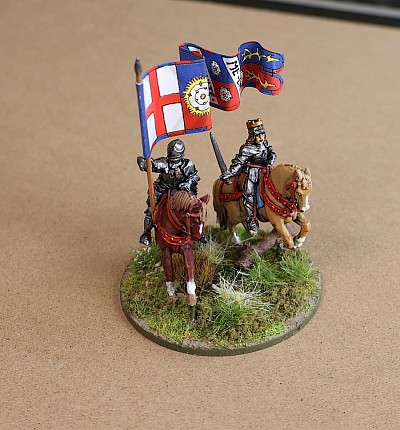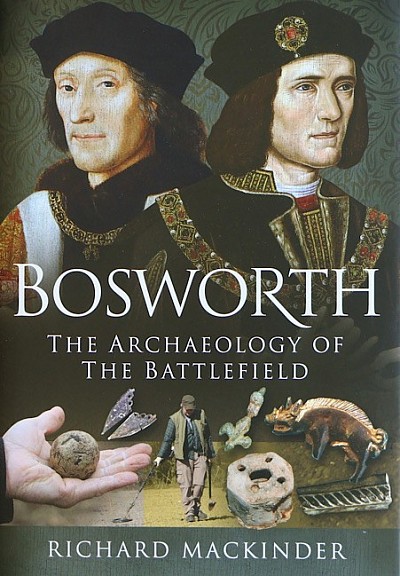The Bosworth 1485 project
Introduction
The Battle of Bosworth, Monday 22nd August 1485, saw the armies of the Lancastrian and Yorkist sides clash, not for the last time (Stoke Field), but certainly it was the most significant moment in the Wars of the Roses, with the Plantagenet dynasty permanently giving way to the Tudors - a true monarchical crossroads for the nation that would reverberate for generations to come.
This project is focused on bringing a Bosworth scenario to the table, which surprisingly is not so straightforward.
[Photo right - King Richard III with Sir Percival Thirwall].
Over recent decades, the site of the battle was thought to have been centred upon Ambion Hill, to the extent that the Local Authority established a visitor centre there. Archaeological examination between 2005 and 2010 funded by the Battlefield Trust, has since established the battlefield to actually be some two miles distant from Ambion Hill and recent authors have adjusted the narrative to accord with that.
However, when buying two books to read up on the battle, I found that each author had a different opinion on how the armies were orientated on the battlefield, one with deployment following the line of field furrows for easier movement and the other formed up against the furrow (a 90˚ difference in facing)!
Add to this the speculation as to where individual commands were located, especially as to the positioning of the Stanley contingents and what of Stanley intentions! Despite progress on fixing the battle location, we are still hostage to 'best guess' on deployment, which in one sense just makes the scenario research a whole lot more engaging.
My armies are mostly built and flagged for the 1471 conflict, reflecting the loyalties of Lords to either Lancaster or York at that time, but I won't get too bothered about that, the flags are just my eye candy rather than a source of getting hung up too much on the exactitude of patronage in 1485 - the soldiers are the thing!
Initial thoughts and sources
It is fair to say that for those interested in the subject, most would have had their knowledge of the Bosworth battle formed by the work of D.T. Williams, reinforced by the existence of the Battlefield Centre at Ambion Hill that includes a museum and battlefield trail around the hill.
The location had drawn minor contoversy and during the early 90's Peter Foss, in his book 'Field of Redmore', suggested that the actual battlefield lay a mile further south west.
By 2010, the well funded (1 million pounds) archeological work of Glenn Foard and Anne Curry with excavated finds was indicating that the battlefield was a further mile south west than Foss had proposed. It now seems to be generally accepted that this is the case and modern texts use location are based on that evidence.
In his book 'Richard III and the Battle of Bosworth' (Hellion & Co) Mike Ingram has the two armies facing off on an east / west axis with a marsh to the Yorkist right. He also has the Yorkist main battle commands lined up behind each other (column), with Northumberland in the rear, potentially explaining his non engagement and the positions show the armies working with the field furrows for easier movement.
Christopher Gravett in his re-working of his earlier Osprey Publishing title, writes after Ingram's book was released and he refers to it when he offers a differing view. He has the armies on a north / south axis with the marsh between the armies and positions the armies deployed fully in line, with Northumberland deployed on the left. The reason for Northumberland's apparent non-involvement is then speculated as being due to problems traversing the boggy ground and / or being held in check by the undeclared Stanley forces out on his left flank and / or simply not having an allegiance to his king.
Gravett's account for deployment does accord with the line of march of both armies.
To help the scenario designer with these opposing views, Richard Mackinder's book 'Bosworth the Archaeology of the Battlefield' offers a precise overlaying of the various archaeology finds onto a map and relates those finds to the positions of the armies. The book is an unusual and excellent technical balance to the previous two titles.
Finally, I have bought a very good source book, this being the new Hail Caesar Wars of the Roses supplement, written by Rob Grayson and published by Warlord Games and which of course includes a Bosworth scenario. This is very interesting as it is somewhat a composite of the Ingram / Gravett proposals, but looks a very interesting set-up in its own right.
It has the armies on a sort of north / south axis, I say sort of because Henry and Richard are on a semi north east / south west axis, but it is the Stanleys who are arrayed in front of Northumberland that overall delivers a north / south preference ..... assuming the Stanleys side with the Lancastrians!
The marsh is directly in front of the Lancastrian position, because their advance along the road has brought them to this point where the marsh exists. It may be as accidental as that or deliberate as a defensive position against the much larger Royal army. I like the fact that Henry has (Captan) Philibert Chandée to his left with the continental units.
I will enjoy researching all of this and doing cover to cover reads rather than snatch browsing. The approach to battle will be important for placing the troops' likely positions and the archeology will be interesting, especially the fall of the cannon balls which may help determine gun positions, though I am a little hesitant to go all in on field finds as they can have more than one explanation.
For example the horse spur found could indicate a cavalry position or clash, but could equally be due to loss by any passing horseman and some scatter could be the fallout from assembly areas or post battle / pursuit activity or previous camps etc. It is a helpful guide, but here, the finds, particularly the cannon shot are in sufficient numbers and wide coverage that they do point to an action of whatever description.
I'm not sure that after all of this that I can pull together a single scenario that I could hang my hat on and even at this stage, I am contemplating a scenario that has a slightly randomised set-up within a tight frame of probability, so the potential for a slightly different scenario each time, perhaps more Bosworthesque than definitive, but I don't want to lose sight of the principle that I do this for fun. We shall see .... I may be some time!


